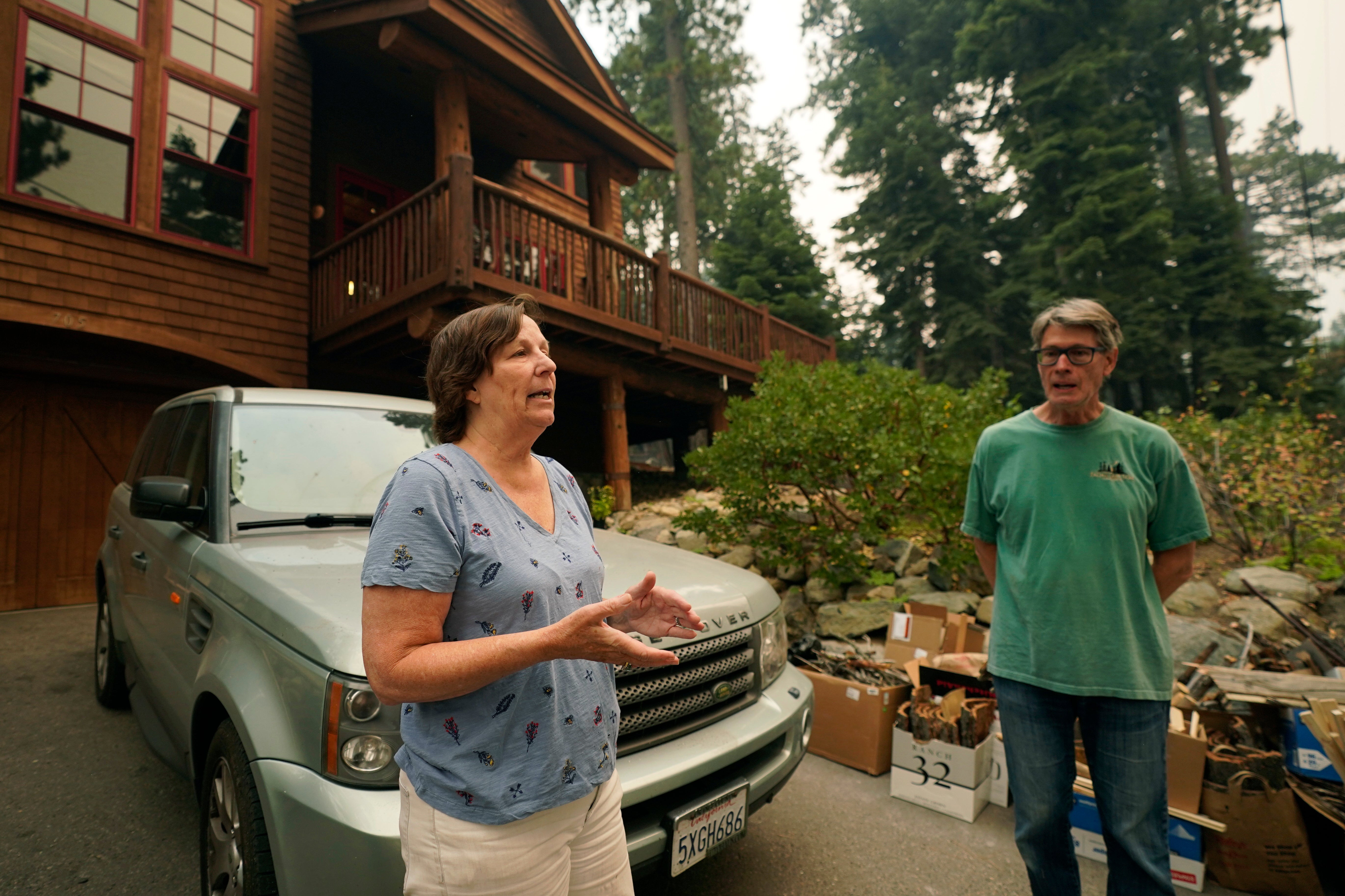Crews struggle to stop fire bearing down on Lake Tahoe
Thousands of firefighters are trying to box in a California wildfire that's advancing toward Lake Tahoe and has shrouded the popular vacation spot with a pall of ash and yellow smoke

Your support helps us to tell the story
From reproductive rights to climate change to Big Tech, The Independent is on the ground when the story is developing. Whether it's investigating the financials of Elon Musk's pro-Trump PAC or producing our latest documentary, 'The A Word', which shines a light on the American women fighting for reproductive rights, we know how important it is to parse out the facts from the messaging.
At such a critical moment in US history, we need reporters on the ground. Your donation allows us to keep sending journalists to speak to both sides of the story.
The Independent is trusted by Americans across the entire political spectrum. And unlike many other quality news outlets, we choose not to lock Americans out of our reporting and analysis with paywalls. We believe quality journalism should be available to everyone, paid for by those who can afford it.
Your support makes all the difference.A California fire that gutted hundreds of homes advanced toward Lake Tahoe on Wednesday as thousands of firefighters tried to box in the flames and tourists who hoped to boat or swim found themselves looking at thick yellow haze instead of alpine scenery.
The Caldor Fire was less than 20 miles (32 kilometers) east of the lake that straddles the California-Nevada state line. The fire was eating its way through rugged timberlands and was “knocking on the door” of the Lake Tahoe basin, California’s state fire chief Thom Porter warned this week.
On Tuesday, ash rained down and tourists ducked into cafes, outdoor gear shops and casinos on Lake Tahoe Boulevard for a respite from the unhealthy air.
Inside the Hard Rock Hotel & Casino, cocktail waitresses in fishnet stockings and leopard-print corsets served customers playing slots and blackjack.
Sitting at a slot machine near a window looking out at cars driving through the haze, Ramona Trejo said she and her husband would stay for their 50th wedding anniversary, as planned.
Trejo, who uses supplemental oxygen due to respiratory problems, said her husband wanted to keep gambling.
“I would want to go now,” she said.
South of Tahoe, Rick Nelson and his wife, Diane, had planned to host a weekend wedding at Fallen Leaf Lake, where his daughter and her fiancé had met. However, the smoke caused most of the community to leave. The sun was an eerie blood orange and the floats and boats in the lake were obscured by haze.
In the end, the Nelsons spent two days arranging to have the wedding moved from the glacial lake several hours southwest to the San Francisco Bay Area
“Everybody’s trying to make accommodations for the smoke. And I think it’s becoming a reality for us, unfortunately,” Diane Nelson said. “I just think that the smoke and the fires have gotten bigger, hotter and faster-moving.”
Climate change has made the West warmer and drier in the past 30 years and will continue to make the weather more extreme and wildfires more destructive, according to scientists.
Although there were no evacuations ordered for Lake Tahoe, it was impossible to ignore a blanket of haze so thick and vast that it closed schools for a second day in Reno, Nevada, which is about 60 miles (100 kilometers) from the fire.
The last major blaze in the area took South Lake Tahoe by surprise after blowing up from an illegal campfire in the summer of 2007. The Angora Fire burned less than 5 square miles (13 square kilometers) but destroyed 254 homes, injured three people and forced 2,000 people to flee.
The Caldor fire had scorched more than 190 square miles (492 square kilometers) and destroyed at least 455 homes since Aug. 14 in the Sierra Nevada southwest of the lake. It was 11% contained and threatened more than 17,000 structures.
On its western side, the blaze continued to threaten more than a dozen small communities and wineries. On the eastern side, crews were bulldozing fire lines, opening up narrow logging roads and clearing ridgetops in hopes of stopping its advance, fire officials said.
More than 2,500 firefighters were on the line and more resources were streaming in, fire officials said.
Big firefighting aircraft were being brought in.
“It’s the No. 1 fire in the country right now ... there’s dozens of crews and dozers and engines and others that are on their way right now,” said Jeff Marsolais, supervisor for the Eldorado National Forest and an administrator on the fire.
The resources were desperately needed.
“This fire has just simply outpaced us. We emptied the cupboards of resources,” Marsolais said, adding that while the blaze had slowed its explosive growth in recent days, “that can change.”
Meanwhile the Dixie Fire, the second-largest in state history at 1,140 square miles (2,953 square kilometers) was burning only about 65 miles (104 kilometers) to the north. It was 43% contained.
Nationally, 92 large fires were burning in a dozen mainly Western states, according to the National Interagency Fire Center in Boise, Idaho.
Northern California has seen a series of disastrous blazes that have burned hundreds of homes and many remain uncontained. On Tuesday, President Joe Biden declared that a major disaster exists in California and ordered federal aid made available to local governments, agencies and fire victims in four northern counties ravaged by blazes dating back to July 14.
___
Melley reported from Los Angeles.
Sam Metz is a corps member for the Associated Press/Report for America Statehouse News Initiative. Report for America is a nonprofit national service program that places journalists in local newsrooms to report on undercovered issues.